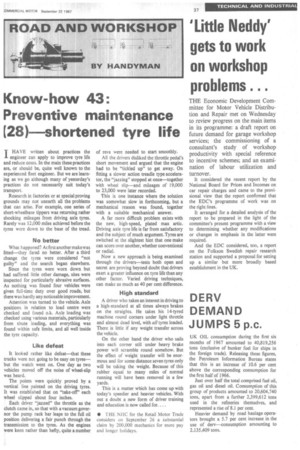Know-how 43: Preventive maintenance (28) shortened tyre life
Page 39

If you've noticed an error in this article please click here to report it so we can fix it.
THAVE written about practices the
engineer can apply to improve tyre life and reduce costs. In the main these practices are, or should be, quite well known to the experienced fleet engineer. But we are learning as we go although many of yesterday's practices do not necessarily suit today's transport.
Research in factories or at special proving grounds may not unearth all the problems that can arise. For example, one series of short-wheelbase tippers was returning rather shocking mileages from driving axle tyres. Rarely was 12,000 miles achieved before the tyres were down to the base of the tread.
No better What happened? At first another make was fitted—they fared no better. After a third change the tyres were considered "not guilty" and the search began elsewhere.
Since the tyres were worn down but had suffered little other damage, sites were inspected for particularly abrasive surfaces. As nothing was found four vehicles were given full-time duty over good roads, but there was hardly any noticeable improvement.
Attention was turned to the vehicle. Axle positions in relation to load centre were checked and Found o.k. Axle loading was checked using various materials, particularly from shute loading, and everything was found within safe limits, and all well inside the tyre capacity.
Like defeat It looked rather like defeat—that these trucks were not going to be easy on tyres— but the watch went on. One day as two vehicles moved off the noise of wheel-slip was heard.
The points were quickly proved by a vertical line painted on the driving tyres. It was established that on "take-off" each wheel slipped about four inches.
Each driver "jazzed" the throttle as the clutch came in, so that with a vacuum governor the pump rack bar leaps to the full oil position delivering a fair punch through the transmission to the tyres. As the engines were keen rather than hefty, quite a number of revs were needed to start smoothly.
All the drivers disliked the throttle pedal's short movement and argued that the engine had to be "tickled up" to get away. On fitting a slower action treadle type accelerator, the "jazzing" stopped at once—together with wheel slip—and mileages of 19,000 to 23,000 were later recorded.
This is one instance where the solution was somewhat slow in forthcoming, but a mechanical reason was found, together with a suitable mechanical answer.
A far more difficult problem exists with the new. high-speed, plated max artic. Driving axle tyre life is far from satisfactory and the subject of much argument. Tyres are switched at the slightest hint that one make can score over another, whether conventional or radial.
Now a new approach is being examined through the drivers—tests both open and secret are proving beyond doubt that drivers exert a greater influence on tyre life than any other factor. Varied driving techniques, can make as much as 40 per cent difference.
High standard A driver who takes an interest in driving to a high-standard at all times always brakes on the straights. He takes his 14-tyred machine round corners under light throttle and almost dead level, with all tyres loaded. There is little if any weight transfer across the vehicle.
On the other hand the driver who sails into each corner still under heavy brake power will scramble round somehow. But the effect of weight transfer will be enormous and for some distance seven tyres only will be taking the weight. Because of this rubber equal to many miles of normal running will have been removed in a few yards.
This is a matter which has come up with today's speedier and heavier vehicles. With out a doubt a new form of driver training and education is now called for....
• THE NJIC for the Retail Motor Trade considers on September 26 a substantial claim by 200,000 mechanics for more pay and longer holidays.




























































































































